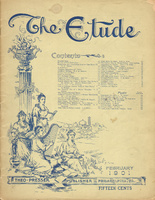E. N. L. — Wagner is pronounced as if spelled Vahg’ner; Tschaikowsky, Chi-kov’ske; Paderewski, Pah-de-rev’ske; Durand, Du-rahnGodard, Go-dahr’.
W. H. W.—1. If a passage is marked glissando, it should be played in that way, and not as if it were a scale passage.
2. François Behr, properly Franz Behr, is a German composer who has written many compositions of a popular salon character, melodious and graceful, and generally effective for the lower grades of piano-teaching. He has also written under the pseudonyms of “William Cooper,” “Charles Morley,” and “Francesco d’Orso.”
A. L. S. H.—Isidor Wilhelm Seiss was born December 23, 1840, at Dresden. He had pianoforte lessons from Frederic Wieck, and studied theory with Julius Otto; later he was at Leipzig with Hauptmann. When he was twenty years old he appeared frequently in concerts, and later settled at Cologne as a member of the faculty of the Conservatorium. His compositions are mostly educational, and are full of taste and well suited to the piano. He also made a number of transcriptions of Haydn’s quartets, and a new edition of Weber’s “E-flat Concerto.”
Anxious Parent.—We have a query from you which is not of sufficient general interest to warrant answer in these columns. If you will send your address to the editor, you will receive an answer by return-mail. We reiterate here that all questions must have the name and address of the sender, if an answer is desired. Should the question be without general value, we will send an answer by letter.
B. C.—When the muscles and tendons of the hand have become strained, the condition is a serious one, and care must be exercised to avoid permanent disability. A physician would naturally, as in your case, advise rest. Yet this difficulty has existed before and has been conquered. In the case of a well-known pianist, who had overworked his hands, restoration was accomplished by bathing the strained muscles with hot and cold water alternately, and by moderate exercise, not complete cessation. The recovery is tedious, but not impossible. Make your practice delicate and slow, never strong nor with an attempt at speed, and stop before you experience numbness or darting muscle-pains. General exercise in the open air and dumb-bell work or calisthenics are helpful.
E. A. H.—The use of a pointer, or baton, in piano- teaching, even in the elementary grades, is of doubtful value. If attention is to be called to any particular passage, the ever-ready lead-pencil should suffice, and for marking time and for enforcing rhythm the metronome is indispensable. It will not be necessary to keep the place, with either pointer or pencil, for a pupil who has received the proper preparatory training in sight-reading. The whole trouble is that a majority of pupils are taken to the keyboard too soon, thus entailing endless trouble and vexation on both teacher and pupil.
G. L.—For a “showy, but not too difficult,” exhibition piece suitable for a promiscuous audience we would recommend either of the following: Larregla, ‘La Coquetuela”; L. Gaertner, “La Scintillata”; Godard, “Second Mazurka.” In The Etude will be found each month a composition of about the grade and character you describe, as, for instance, the “Ballet Mignon,” by Wachs, in the January issue.
D. D. A.—The apparent contradiction between the Italian terms denoting varying degrees of tempo and the figures on the face of the metronome has puzzled many. The terms are given in their proper order from largo to presto simply to show their comparative slowness or rapidity of movement. They have no connection with the figures used to indicate the position of the pendulum.
When the sign M.M. quarter-note = 72 is given, you are playing at the rate of seventy-two quarter-notes to the minute, and when the sign M.M. half-note = 72 is given you are playing seventy-two half-notes to the minute, or just twice as fast.
The bell on a metronome is usually adjusted so as to ring on the first beat of each measure.
G. W.—Bendel’s opus 135 is a suite of descriptive pieces based on various German folk-legends. “Frau Holle” may be characterized as a sort of Teutonic “Mother Goose.” In Germany, when the snow-flakes are falling, the household saying is that “Frau Holle must be shaking up her feather-beds.” This should suggest to you the proper interpretation (light and delicate) of the composition in question.



